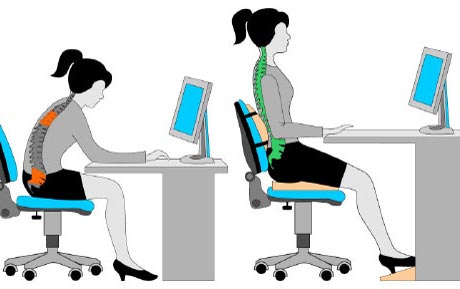Poor posture can lead to many aches and pains, most commonly, head aches, shoulder pain, and back pain. Typical posture deviations that can lead to pain include forward head, rounded shoulders, rounded back, and arms rotated in (thumbs point towards body when hanging down instead of forward). When these positions are maintained in a person the muscles that are being stretched become weak and the muscles that are shorted become tight and inefficient. This leads to poor control of the area, which eventually leads to pain.
So what does good posture look like?
Just like your grandmother always said “stand/sit up tall!”. If you try to be as tall as you can be, the back of your head should raise slightly and you should have a slight tuck of your chin. Your shoulders should be held down and back. When these two postures are corrected your ear lobes should be in line with the middle of your shoulder. Most likely this feels very awkward for you and you may not be able to maintain it for a very long period of time. The other posture that is important, especially for sitting, is a slight low back curve, called a lordosis. When sitting in a chair, if this is not supported it can lead to poor posture up the back and into the shoulders and neck, as well as contribute to low back pain. If you do not have the muscle endurance to perform this independently, I recommend placing a small pillow or rolled up towel in the small of your back when sitting for long periods, like while driving a car or working at a desk.
What can you do to improve your posture?
Always try to sit and stand tall. If you have had poor posture for a long period of time, and some muscles have become tight and others weak, there are some stretches and some strengthening exercises that you can do to restore your muscle balance. If you are having pain related to postural changes I recommend seeing a physical therapist to get a program designed for you.
An easy way to see how posture is important is to slump forward and try to lift your arm above your head. How far can you reach up? Now be tall with shoulders rolled back and down and your head held high, raise your arm again. How much further could you reach and how much easier was it? If you have shoulder pain already, did the pain improve with improved posture? Now, try the same thing with your thumb rotated down and then try with the thumb pointing up.

